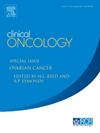Patient Perspectives on the Value of Stereotactic Body Radiotherapy in the Management of Breast Cancer: The PERSPECTIVE Study
IF 3.2
3区 医学
Q2 ONCOLOGY
引用次数: 0
Abstract
Aims
Oligometastatic disease describes limited metastases amenable to therapy such as stereotactic body radiotherapy (SBRT). This study aims to understand which outcomes are most important to patients when considering SBRT as a treatment option. The insights gained will help inform future patient-directed trial endpoints and provide valuable guidance to clinicians supporting patients through their decision-making process.
Materials and Methods
We conducted a qualitative study with focus groups and individual interviews. Participants were recruited using a purposive-sampling matrix accounting for age, presence of metastatic disease, and previous experience with radiotherapy. Each focus group had at least two moderators, and all interviews were digitally recorded and then transcribed. Thematic analysis was performed using NVivo version 12.
Results
The study included 18 patients diagnosed with breast cancer, comprising two focus groups and four individual interviews. The median age was 54 years (range 38–74). 15/18 (83%) had prior radiotherapy experience, including 4/18 with previous SBRT experience. Three main themes were identified: 1) Participants' experience with radiotherapy; 2) patients' perceptions and considerations in relation to SBRT (including desired treatment outcomes); and 3) willingness to consider SBRT for its potential local control and durable pain control benefits, even in the absence of survival benefit. Participants prioritised extending their lives as the foremost desired outcome of SBRT, followed by quality of life. Those with prior SBRT experience were keen for repeat treatment, if available, and emphasised SBRT's minimal side effects compared to other interventions.
Conclusion
While extension of life was the primary desired treatment outcome of SBRT for oligometastatic breast cancer , all participants were willing to consider SBRT for its minimal side effects and potential benefits in local control and durable pain control, even in the absence of a survival benefit.
立体定向放疗在乳腺癌治疗中的价值:透视研究。
目的:少转移性疾病是指可接受立体定向体放射治疗(SBRT)等治疗的有限转移灶。本研究旨在了解患者在考虑将 SBRT 作为一种治疗方案时,哪些结果是最重要的。所获得的见解将有助于为未来以患者为导向的试验终点提供信息,并为临床医生在患者的决策过程中提供有价值的指导:我们通过焦点小组和个人访谈进行了一项定性研究。根据年龄、是否患有转移性疾病以及以往的放疗经验,采用目的性抽样矩阵招募参与者。每个焦点小组至少有两名主持人,所有访谈均进行数字录音,然后转录。使用 NVivo 12 版本进行了主题分析:研究包括 18 名乳腺癌患者,其中包括两个焦点小组和四个个人访谈。中位年龄为 54 岁(38-74 岁不等)。15/18(83%)的患者曾接受过放射治疗,其中 4/18 曾接受过 SBRT 治疗。研究确定了三大主题1)参与者的放疗经验;2)患者对 SBRT 的看法和考虑(包括期望的治疗效果);3)即使没有生存获益,患者也愿意考虑 SBRT,因为它具有潜在的局部控制和持久的疼痛控制获益。参与者将延长生命作为 SBRT 的首要预期结果,其次是生活质量。那些曾经接受过 SBRT 治疗的人热衷于重复治疗(如果可以的话),并强调与其他干预措施相比,SBRT 的副作用极小:虽然延长生命是SBRT治疗寡转移性乳腺癌的主要预期疗效,但所有参与者都愿意考虑SBRT,因为其副作用极小,即使没有生存益处,也能在局部控制和持久疼痛控制方面带来潜在益处。
本文章由计算机程序翻译,如有差异,请以英文原文为准。
求助全文
约1分钟内获得全文
求助全文
来源期刊

Clinical oncology
医学-肿瘤学
CiteScore
5.20
自引率
8.80%
发文量
332
审稿时长
40 days
期刊介绍:
Clinical Oncology is an International cancer journal covering all aspects of the clinical management of cancer patients, reflecting a multidisciplinary approach to therapy. Papers, editorials and reviews are published on all types of malignant disease embracing, pathology, diagnosis and treatment, including radiotherapy, chemotherapy, surgery, combined modality treatment and palliative care. Research and review papers covering epidemiology, radiobiology, radiation physics, tumour biology, and immunology are also published, together with letters to the editor, case reports and book reviews.
 求助内容:
求助内容: 应助结果提醒方式:
应助结果提醒方式:


